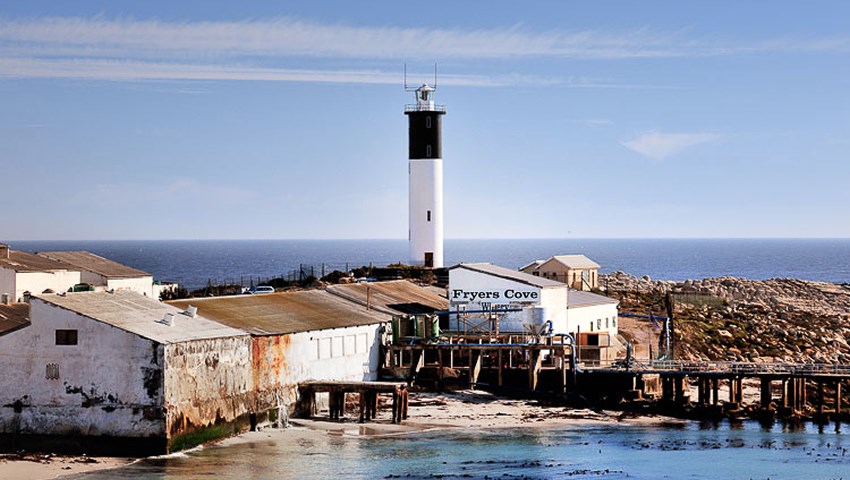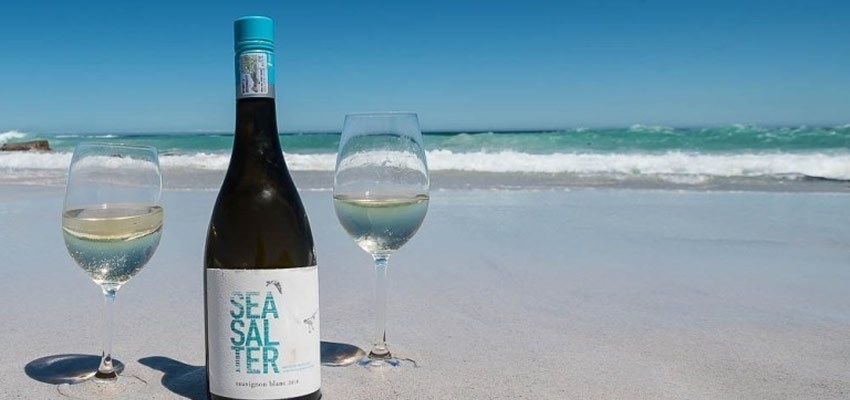The name Sauvignon Blanc means ‘wild white’ as it once grew wild in the South of France—and now with vineyards on the edge of the Atlantic, wild white meets wild seas for a flavour profile utterly unique to the tip of Africa.
This perceived salinity tastes of fresh seaweed, a steely minerality, and the umami of kelp. The Bamboes Bay Sauvingon Blanc 2016 from Fryer’s Cove does all of this and more. It’s a wine I would travel to the edge of the world for—and in some ways I have. Fryer’s Cove Winery is located on the West Coast, approximately a four-hour drive from Cape Town to Doringbaai (Doring gone I joked on the way there…).
Doringbaai is a small town curled along the edges of the coast, with an amphitheatre of sky above, and a wild ocean below, the combination of which makes for kaleidoscopic sunsets. Fryer’s Cove is its castle. The winery and cellar are located on what was once a fish factory, with a tasting area and restaurant on its deck, and a jetty running into the ocean.They’ve used this proximity to the Atlantic to their benefit: by piping water through stainless steel pipes, cooling it in the frigid water and running it through the tanks of the winery to regulate temperatures.
The vineyard for the Bamboes Bay Sauvignon Blanc is located nearby, eponymously named; the Afrikaans ‘bamboes’ translates to ‘kelp’, and is an homage to its maritime location.
“It is truly mesmerising to work so close to the sea,” shares winemaker Derick Koegelenberg. “The scenery changes as the tides do. It’s easy to get drawn into the waves, sun, wind and vastness that you forget about everything—all you need is a glass of wine!” A perk of the job he says is that he often buys fresh fish from the jetty as the local fishermen pass by.

Fryer's Cove
“Bamboes Bayis the smallest Wine of Origin in South Africa,” he tells me with pride.
“The sea has an enormous impact on the Sauvignon Blanc. This is what truly makes our wines unique. The vineyard is 500 metres from the ocean and this gives a cooling effect from the cold Atlantic. The mists off the sea also carry salt in the vapour, this flows in over our vines and we think it must have an effect as a pest controller too.
“There is a definite influence of the ocean on our vineyard. We get many misty days during our ripening period, and the waves that bombard the cliffs cause a hazy mist that deposit a thin layer of salty flakes on our, that you can taste but not see, and eventually comes through in our wines. Sensorially you taste this as kelp or any association that you can make with the sea. As our Bamboes Bay wines age we have found that this flavour intensifies over time.”
It’s not just the vineyards that have this sea-infusing effect, much like coastal whisky distilleries, the proximity to the ocean plays a part in vinification too.
Derick agrees: “Maritime whisky tasters often talk of ocean spray, brine, kelp, seaweed on the nose of these whiskies, especially Islay malts. We believe something similar happens at Fryer’s Cove.”
The aim of official organisation (and recently re-named) Sauvignon Blanc South Africa is to foster excellence in the industry as well as to promote the cultivar not only locally, but also to the world at large. When I asked chairperson RJ Botha, what he thinks of maritime Sauvignon Blanc, and if we can classify it as a style, he says: “yes, there is a distinct difference to the wine, it’s as if you can taste the sea. This hasn’t yet been proven, but there are a couple of theories around it and the impact of salt water. I think the biggest effect is on the average temperature of the vineyard and that in turn on flavour. The closer you are to the sea the more moderate the temperature and therefore the less temperature spikes you experience.”
A little closer to Cape Town along the West Coast is the historic, 18th century Groote Post Vineyards. They’ve recently released a wine, called the Seasalter Sauvignon Blanc 2018. The label with its clean, contemporary design of blue and white is said to represent the soul of the West Coast: ‘the pristine turquoise waters of the Atlantic, the simplicity of the wind-swept coastline, the weathered white-washed fishing villages, the seagulls calling from above’.

Seasalter from Groote Post Vineyards (photo: The Little Hedonist)
On the origin of the wine, winemaker Lukas Wentzel says: “It was one of those evenings when Nick [Pentz, owner of the wine farm] and I were relaxing over some wine, and the idea for the Seasalter was born. This was in 2014. The first was made in 2015. The end product was very good and we decided to bottle the wine, but then without a name. Nick went over to the U.K and ended up in a small village called Seasalter, which had been a centre for salt production in the Iron Age. And bang there it was, a name for the wine. Just perfect.
“The wonderful thing about Sauvignon is that you can make so many different styles,” continues Lukas.“The ocean has a definite impact: the icy Atlantic and the invigorating salty sea mist. That and our soils have been exposed to the ocean for millions of years. That is definitely the biggest contributor to the salinity in the wine. Stellenbosch University was here for soil analysis and confirmed this.”
Lukas has added a small percentage of Semillon to the Seasalter. “It just adds minerality and guts to the wine.”
Another winery with an ocean view is Cape Point Vineyards, situated in Noordhoek on the Cape Peninsula. Here blocks of Sauvignon Blanc and Semillon fan across granitic soils, overlooking the wide blue expanse of the Atlantic Ocean. This is the domain of winemaker Riandri Visser aka the Siren of Sauvignon, who says she can smell the ocean in the cellar when she works. All the Cape Point wines have a distinct flavour profile, seaside minerality that Riandri deems: “refreshing, like the surf washing over pebbles on the beach.” Riandri’s favourite place is in the vineyard; where she even admits to licking the vine leaves and tasting salt.
Winemaker (and surfer) Trizanne Barnard is another Cape Peninsula local who also makes her wine at Cape Point Vineyards, though she harvests her grapes from the wild and coastal Elim.
“Saline, mineral, it could be more a sensation than an actual smell,” says Trizanne when I ask her about oceanic Sauvignon Blanc.“It could also refer to an iodine smell thanks to higher iron content in the soils in Elim. Ferricrete elevates the mineral notes in the wine. I haven't tested for actual salt-deposits on the skins, but perhaps more in psychosomatic response—thinking about ocean and tasting it in the wine, whichever way, I love the fact that there is an ocean connotation in my wines, I love the energy of the ocean.
“The wind, soils, proximity to ocean, cooling effect, long ripening—are all super important for the structure and flavour profile of the wines.”
Salt in the mist, iron and fossils in the soil—whatever it is, all I know is that when I’m sitting on that jetty at Fryer’s Cove, with the ocean stretching before me with a cold glass of Bamboes Bay Sauvignon Blanc 2016, I taste the sea.
I can’t but help but think of this quote by Robert Henri: “Why do we love the sea? It is because it has some potent power to make us think things we like to think.” And in the case of Sauvignon Blanc, wines we really like to drink.